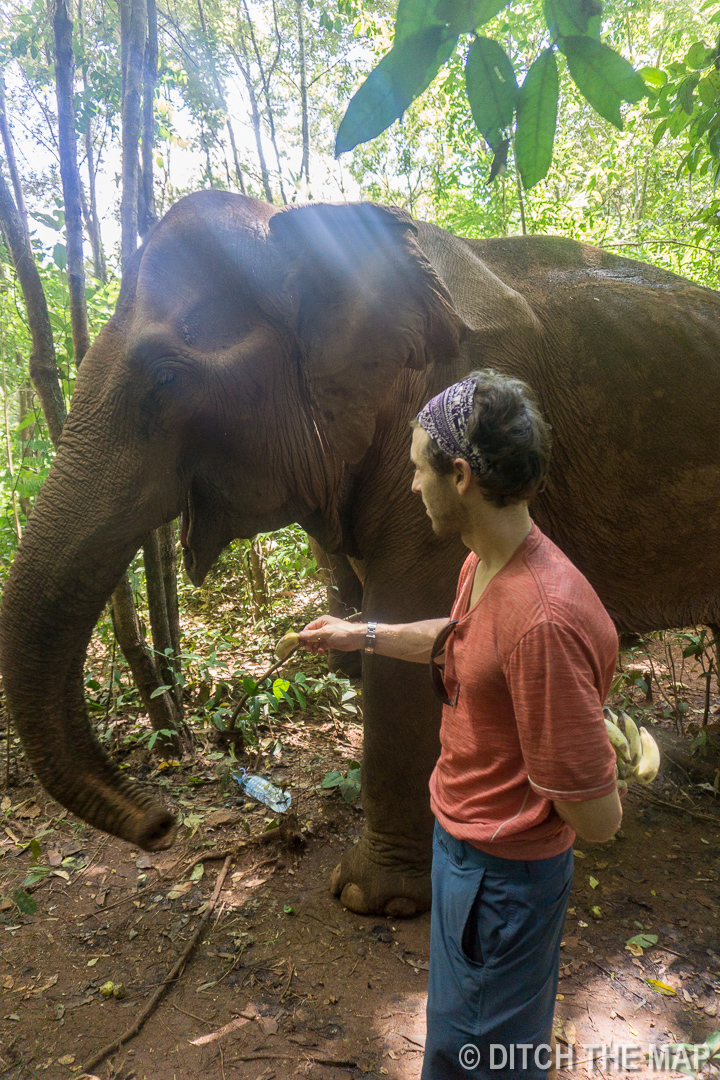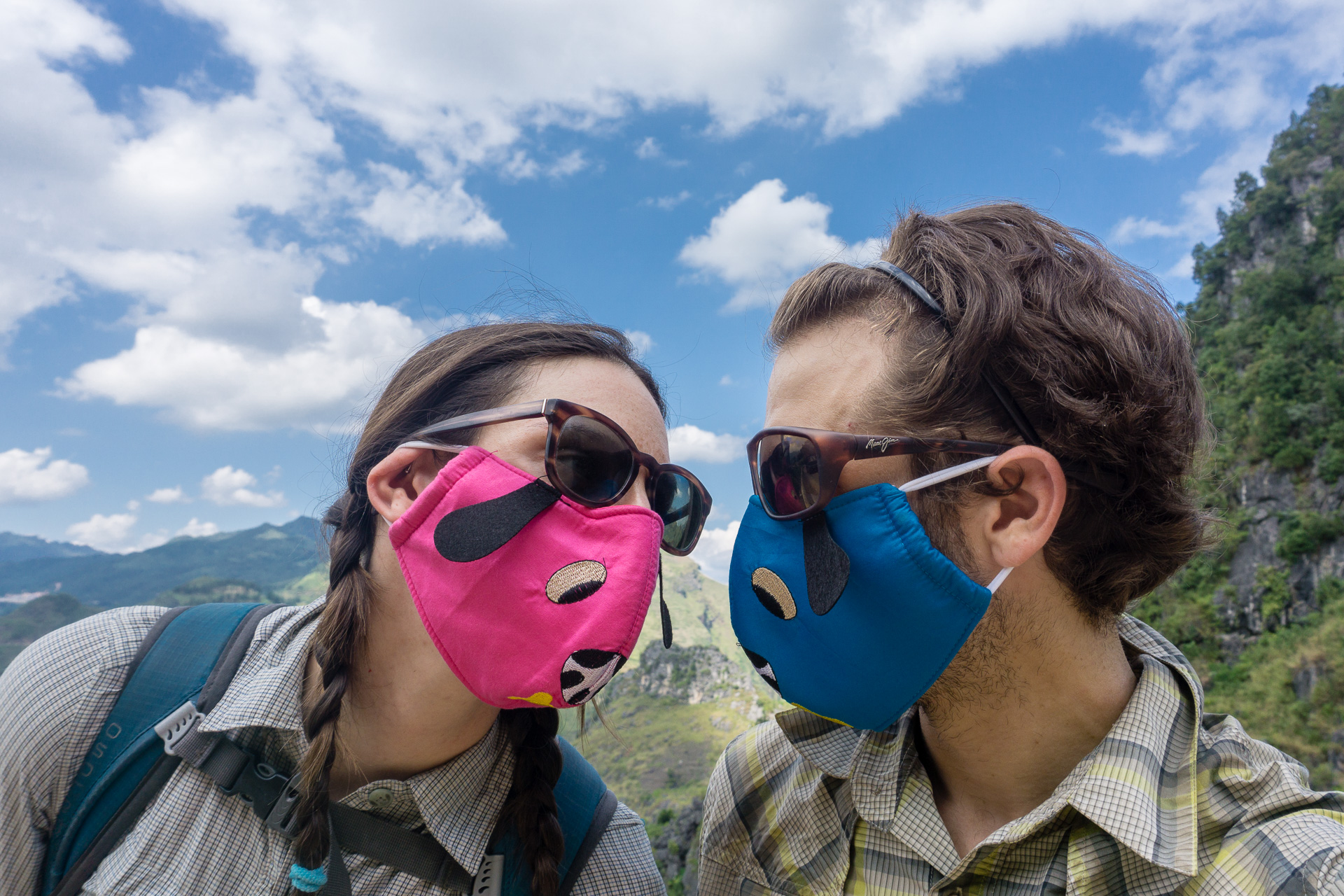2 Days in Mondulkiri, Cambodia
/August 30 – September 1, 2016
Getting to Mondulkiri
After comparing options and prices at several agencies we booked a direct bus from Siem Reap to Mondulkiri. We are told to wait outside of our hotel at 6:45am but we didn’t get picked up until 7:30. Though we paid (over-paid even despite negotiating) for a direct bus a small hellish minivan was greeted us. Sylvie and I were not happy, we instantly knew the 6-hour drive we were promised would be more of an all-day ride. We tried to communicate our frustrations to the driver but unfortunately he and almost everyone else already on the van spoke no English. There were only two seats left. One seat crammed next to the driver and the last available seat was a folding chair with a tiny backrest. Ugh.
We finally found someone to translate for us and learned that this van was just the pick-up vehicle and that we were catching our bus just outside the city. Thank goodness! However, our actual bus didn’t leave until 9 and everyone else on the bus, all locals absolutely did not, I can assure you, pay the outrageous $18 ticket that we did.
Stopping at a Local Market En Route to Mondulkiri, Cambodia
Taking a Minivan to Mondulkiri, Cambodia
Turns out our ‘direct’ bus was anything but direct. For several hours we stopped every few minutes honking like crazy, picking up people and dropping them off. Apparently we were on some type of public bus. Finally after a few hours we stopped in a small town and the entire bus emptied. We were kicked off the bus only to discover we had to switch over to a non air-conditioned van. We rode in the very back seats, which didn’t recline, for a few more hours. Again, we stopped in an even more remote town and were told we needed to switch vehicles yet again. Some direct ticket we purchase, huh? Each vehicle we entered was substantially worse than the last and this van was missing a rear window, had only 5 seats, and sat 16 of us. Sylvie and I sat on a large sack of rice in the back of the van. It was a very bumpy and uncomfortable experience that lasted another few hours.
Sitting on a Sack of Rice While Taking a Minivan to Mondulkiri, Cambodia (click to view)
Finally, by 8:00pm we had arrived to the province of our destination, Mondulkiri. We were dropped on the side of the road, but luckily a women on our van spoke some English and called our lodge to come pick us up. Pretty promptly we were picked up by our lodge. We hopped in the back of the pickup truck that already had half a dozen other backpackers who had just arrived from Phnom Penh. The 6-hour direct bus that we bought tickets for ended up being a 13-hour journey that required 4 separate vehicles.
Inside Our Bungalow in Mondulkiri, Cambodia
Our Bungalow in Mondulkiri, Cambodia (click to view)
Mondulkiri Province and Sen Monorom City
Mondulkiri is the original ‘Wild East of the country’. The province is home to the hardy Bunong (Pnong) people and their noble elephants. The Bunong make up only 1% of Cambodia’s population, while the Khmer make up 90%. This is the land of bears, tigers and elephants. Luckily for us it’s 800m above sea-level elevation, which means we’ll be enjoying some cooler nights, finally. The province is comprised of ethnic minorities, the Bunong people making up almost half the population. Recent deforestation due to logging and the influx of Khmer migrants have caused the Bunong (and other minority) populations to suffer. The roads are poor but recently a road has been built to connect to the city to Phnom Penh, the country’s capital city.
Sen Monorom: The provincial capital, Sen Monorom has only 10,000 inhabitants, and is really an overgrown village. There isn’t much to do in Sen Monorom, all the activity happens nearby—visits to Bunong villages, elephant ecotourism, and several overnight jungle treks. We signed up for a 2-day/1-night elephant and jungle trek.
Enjoying a BBQ in Mondulkiri, Cambodia
Mondulkiri Project
There are a handful of elephant tours in the area and we landed on the Mondulkiri Project after 2 minutes of Google searching. Sylvie had told me to look up a particular company but I misheard her and found this one. Before confirming with her I had already sent an email requesting two spots on a tour for the following day. Later we looked into the company and saw that they were ranked #1 in Trip Advisor. Their reviews from other travelers were marvelous. We booked a night in an affiliated bungalow for $5.
Driving to the Mondulkiri Project in Cambodia
The company is locally owned and practices sustainable tourism—something that neither of us gave two thoughts about just one year ago. They do not permit riding the elephants. We will be walking 18km in the Cambodian jungle and metting 6 elephants. We’ll be feeding, washing, and swimming with them. We will also be guided by a Bunong guide to visit local villages, spot wildlife, swim in waterfalls, sample local rice alcohol, and eat tasty regional curries. The night will be spent sleeping in a hammock deep within the least-touristed part of the Cambodian Jungle’s
Elephants
We hopped into the back of a pickup truck, along with a dozen other travelers, and headed over to the elephant reserve. We were all excited to spend the day with the elephants. We got to bathe and feed them. There were 6 elephants in this project. Hardly any elephants reside in the wild any more. Most of them are employed in logging and other manual labor. It's also common for elephants to be sold to places like Siem Reap where tourists can pay for elephant rides. Not only is it completely unethical for humans to ride on the back of elephants but they are often tied up and live in poor conditions. Elephants eat between 12-18 hours a day. When elephants are put to work they don't get enough time to eat and they slowly loose weight. Elephants in the tourist or logging industry die prematurely.
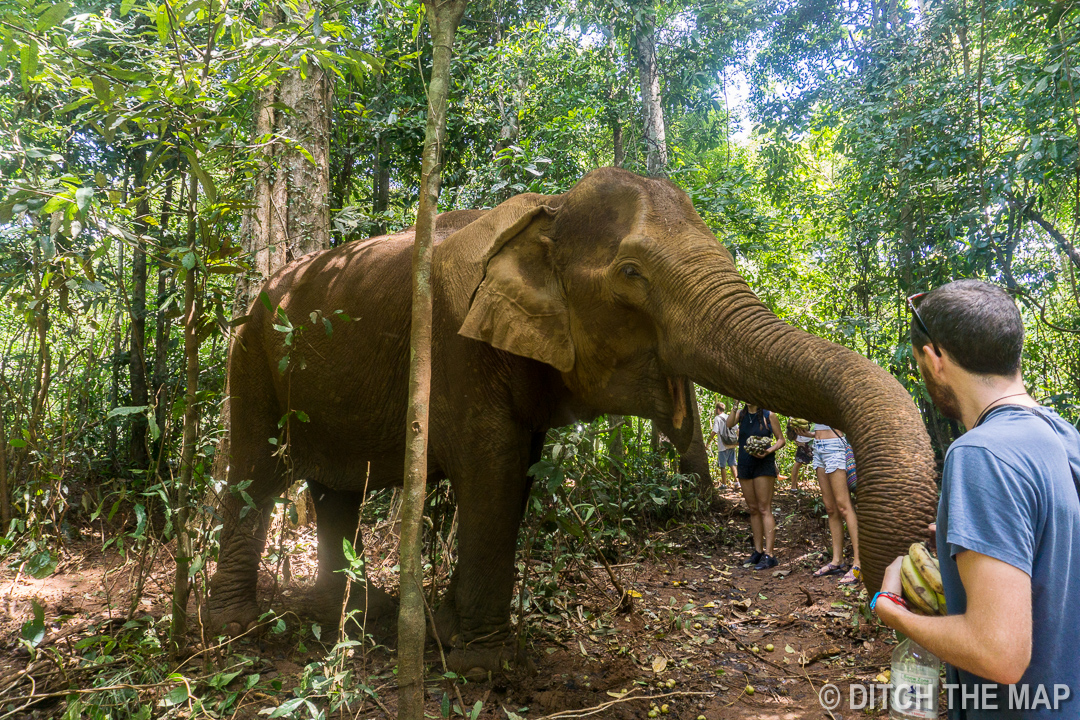
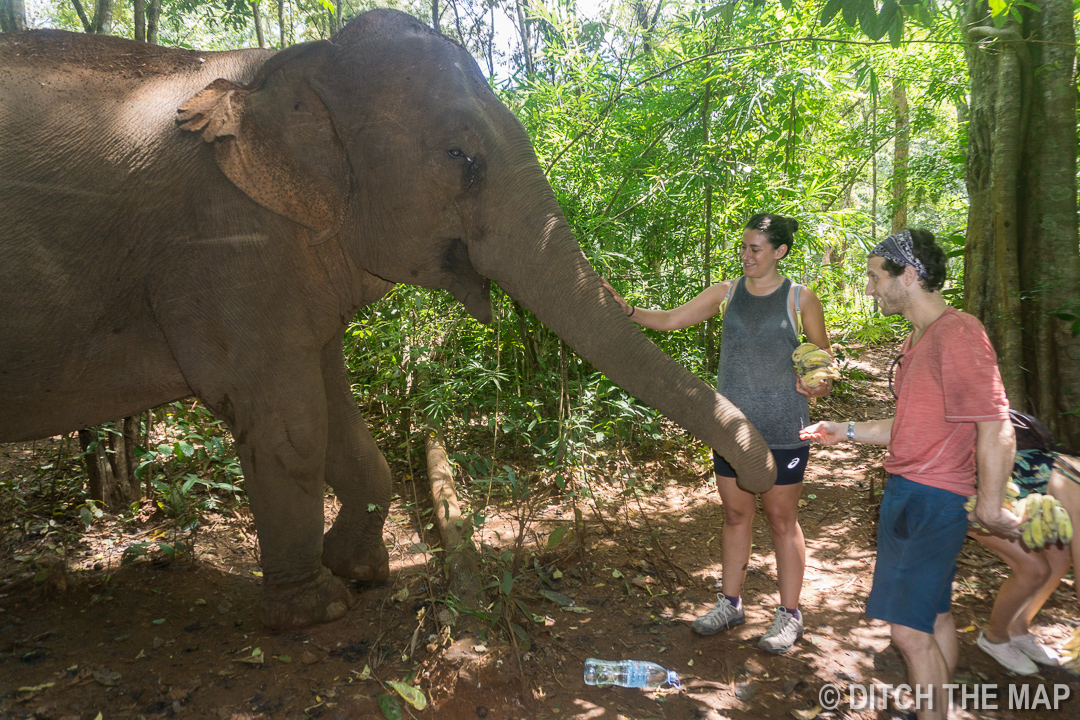
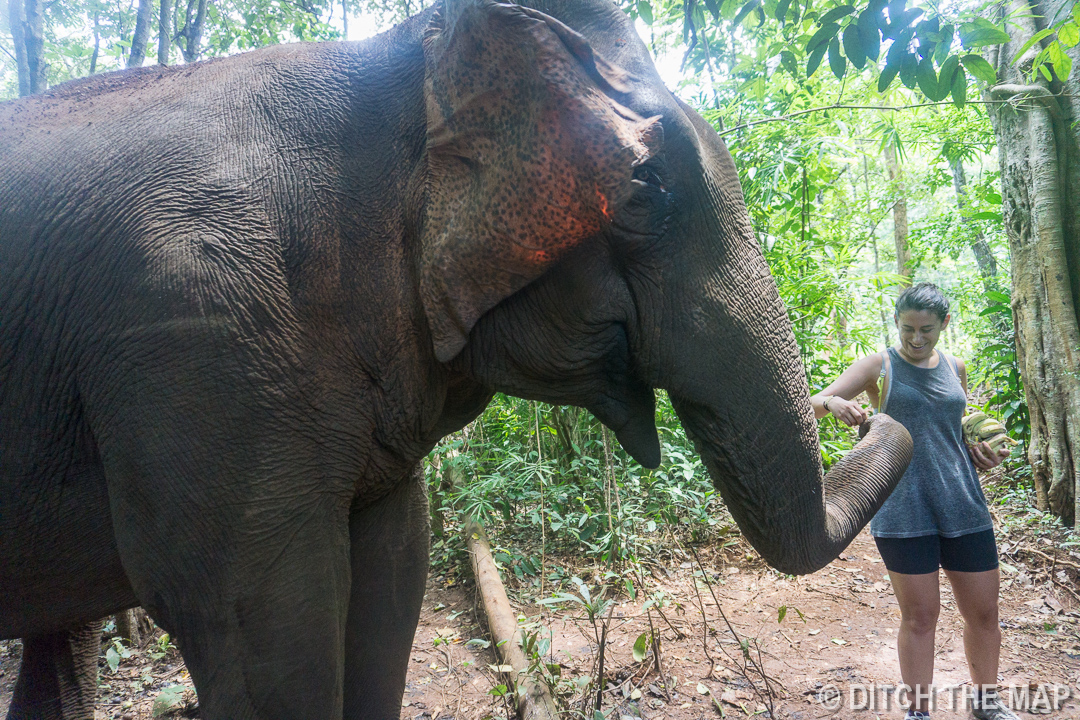
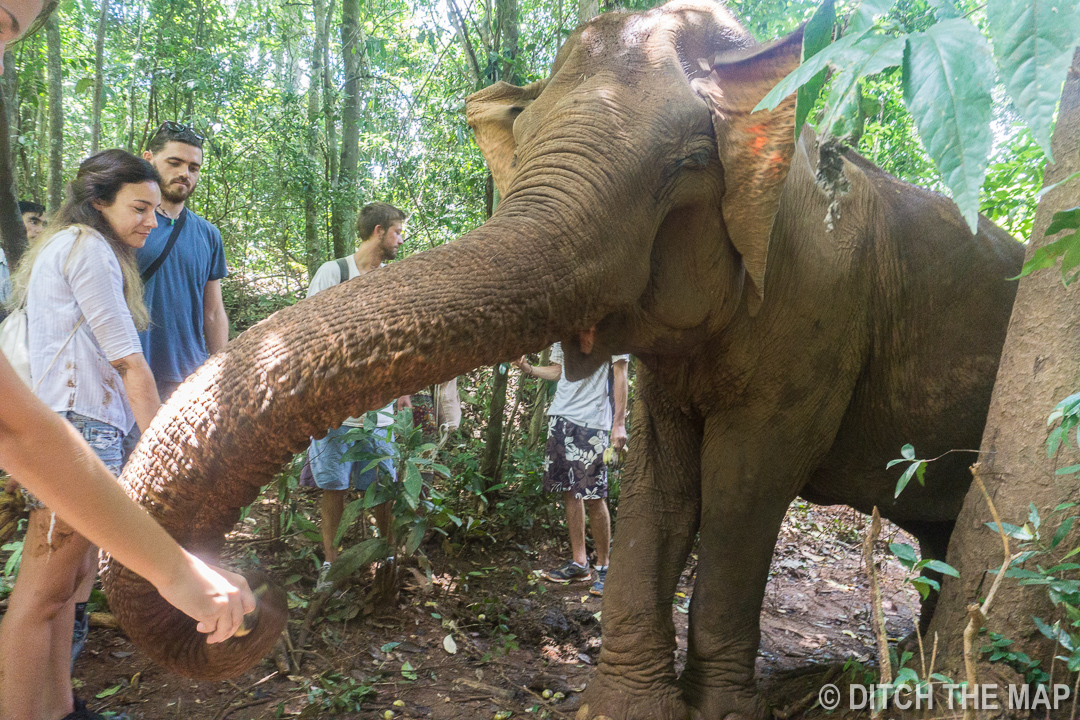
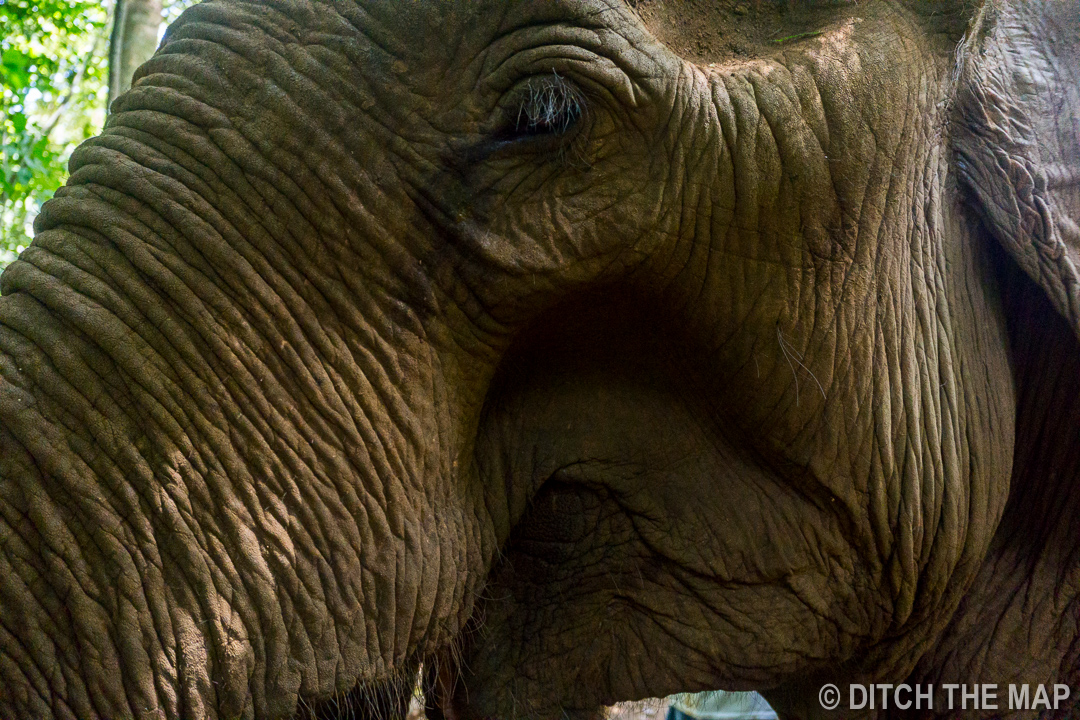
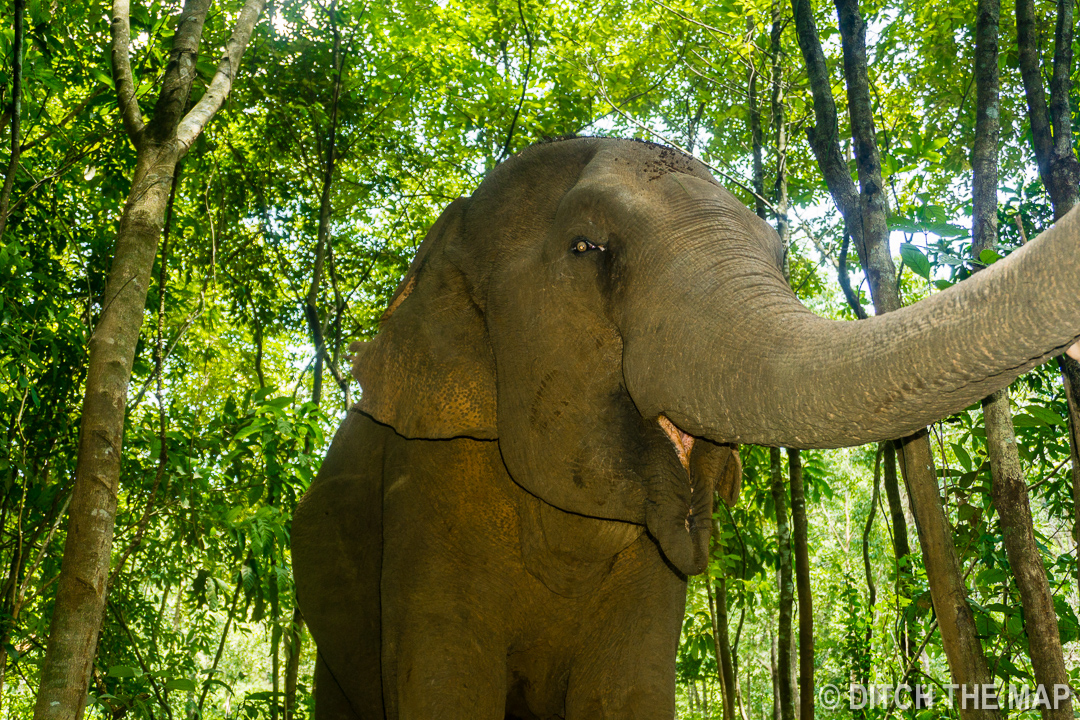

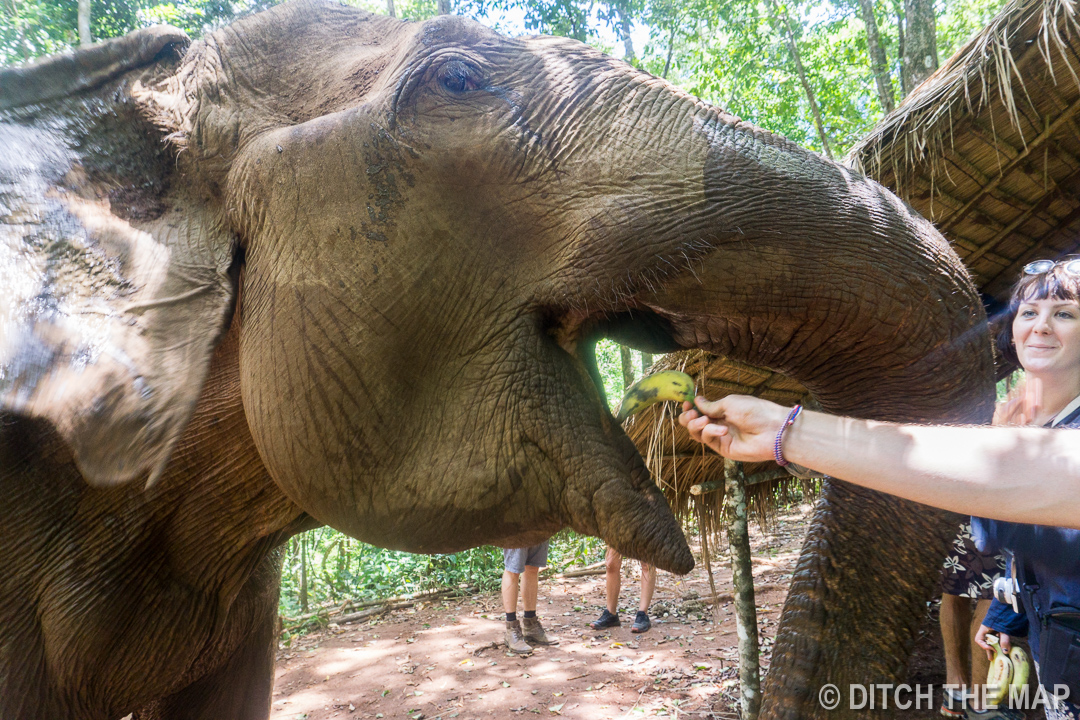

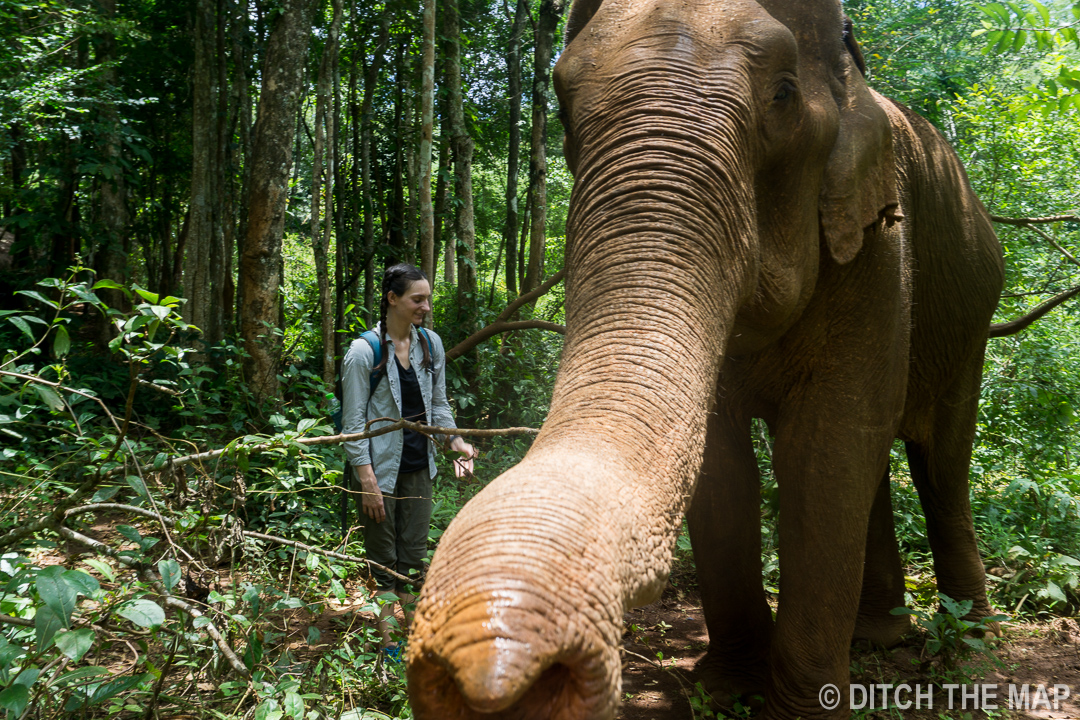
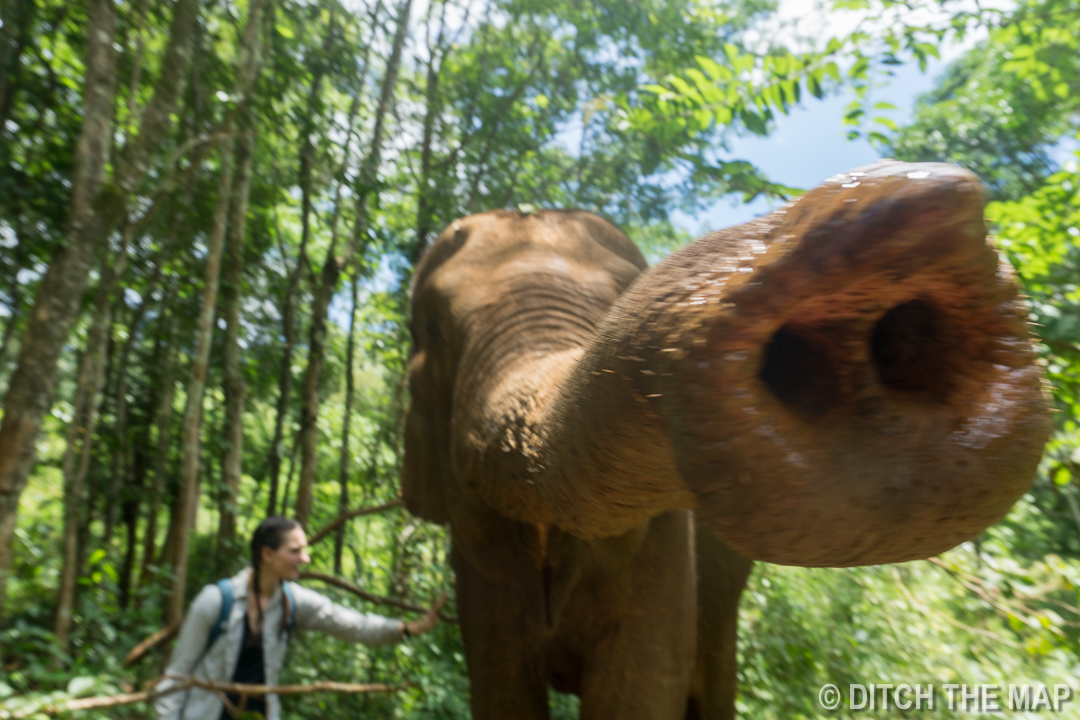
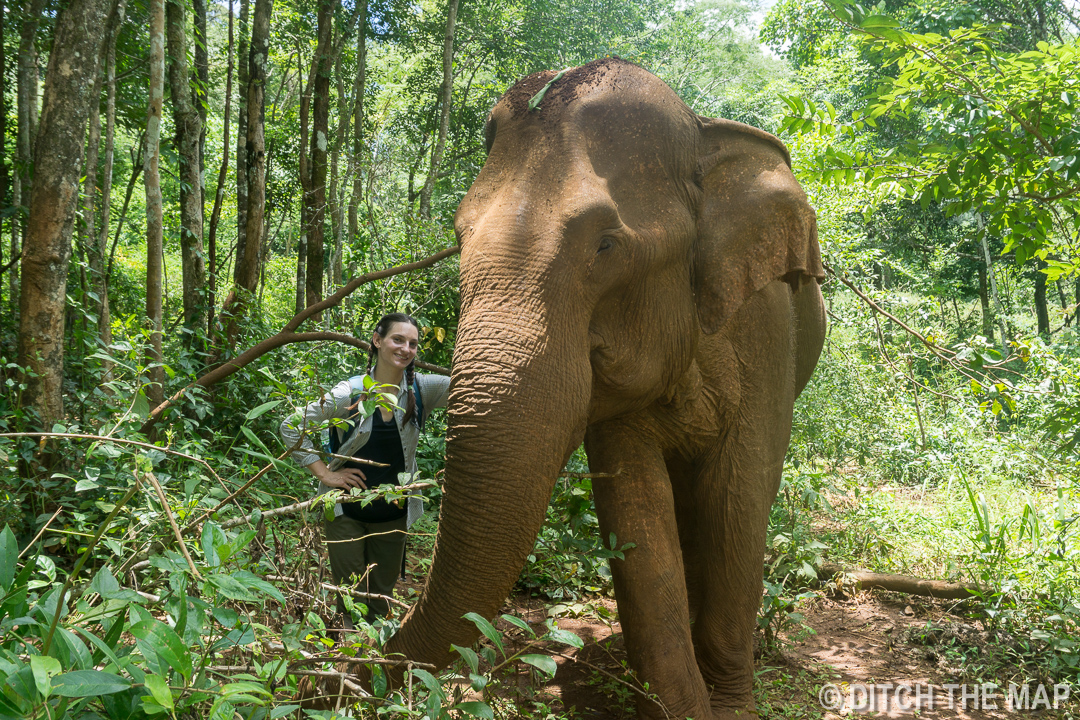
Feeding an Elephant from my Mouth in Mondulkiri, Cambodia
This eco-tourism project, along with many others in the area, purchase the elephants from the tourist and logging industries for around $41k per elephant. They treat the elephants with respect and allow them the entire jungle to roam free. The elephants are fed bananas and graze on the nearby vegetation. If an elephant is not in the mood to be bathed or interact with the visitors they are not forced. They are never ridden by humans. We paid $50 each to spend the day with the elephants, which sounded like a lot to me. After learning more about the project I now see that the cost helps pay to purchase the elephants. Both riding elephants and the labor they provide for the logging industry bring in a lot of revenue, thus their hefty price tag. It's interesting that elephants no longer exist in the wild in Asia as they have in the past. They are all owned! Eco-tourism simply ensures that the animals are owned and treated in a more humane way.
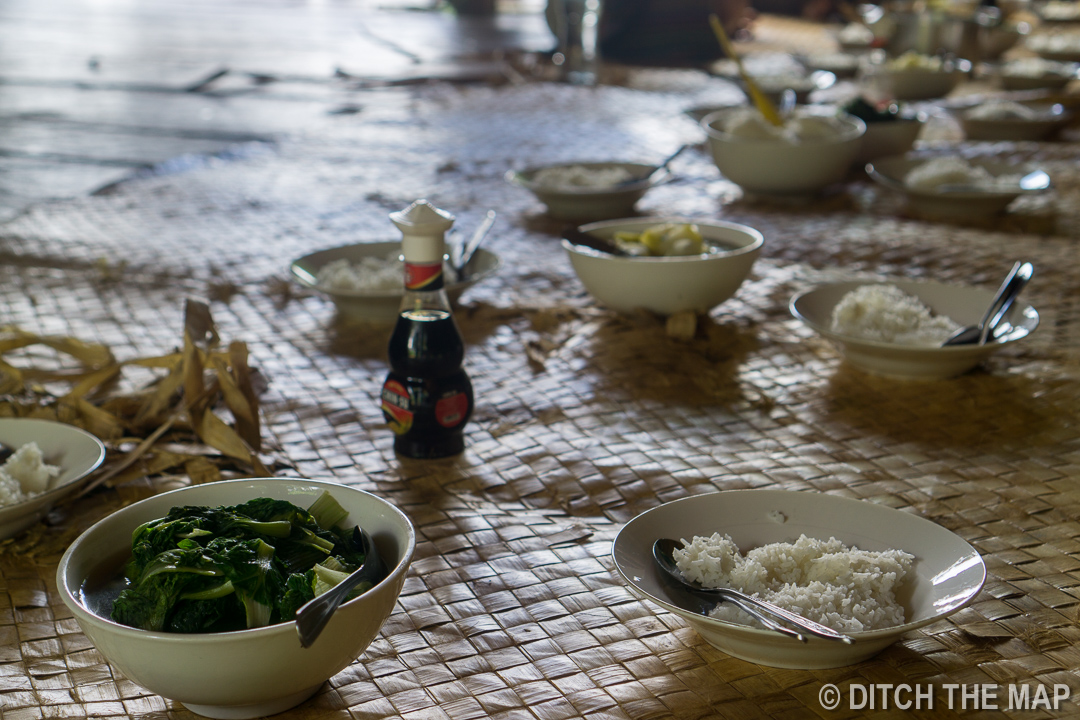
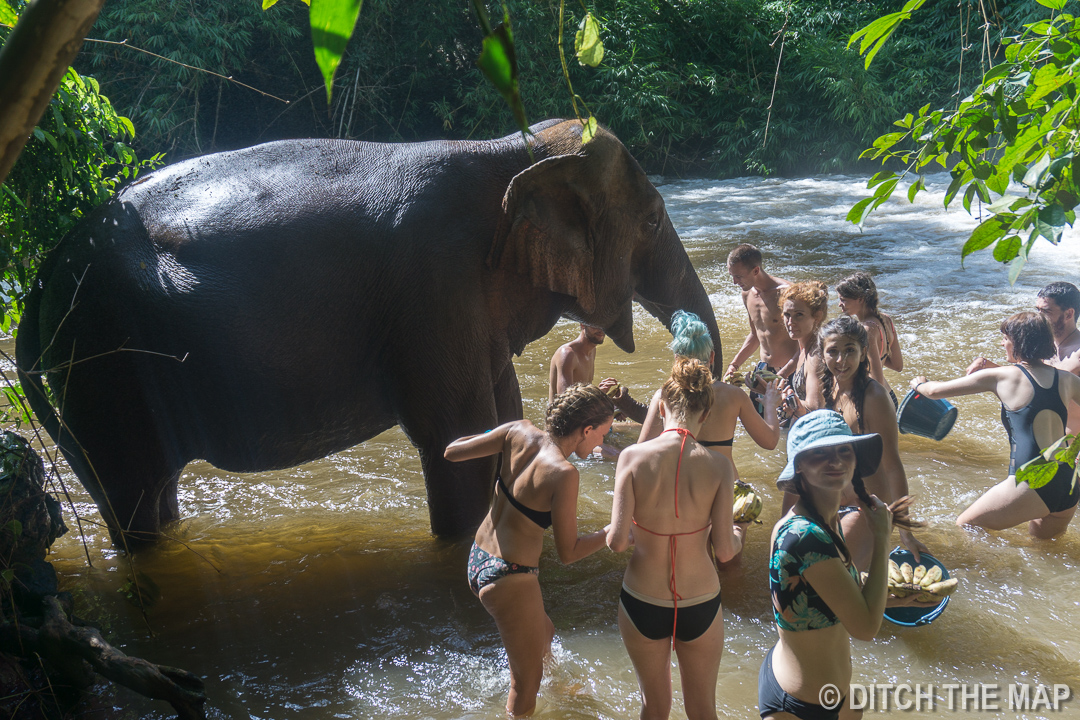
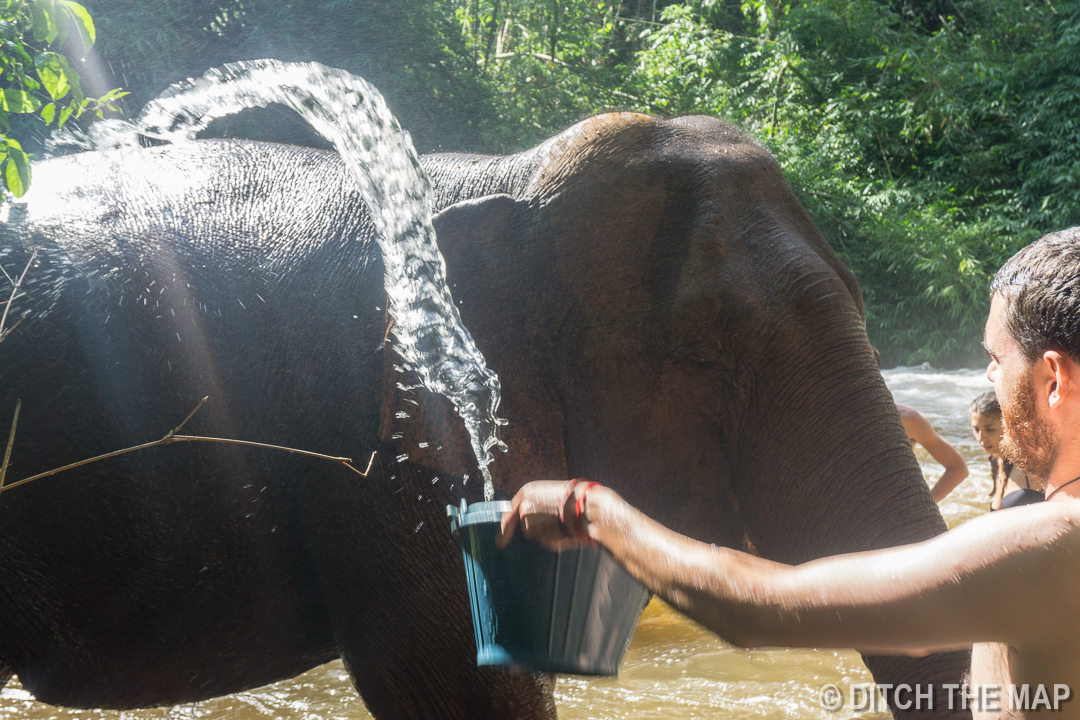
Jungle Trek with Bunong Guide
There were 15 of us that spent the day with the elephants. At 4pm 10 of the travelers left, while Sylvie, myself and 3 Spanish girls stayed back and spent the night in a jungle lodge. The 5 of us were spending the following day hiking 18km to a Bunong Village. The extra day cost us $25/each. Back at the lodge we relaxed, read, and some of the ladies painted the sunset. We set up our U.S. military hammocks that were left over from the war. A little after 6pm we had dinner, which consisted of rice, chicken and long beans, and an amazingly interesting bamboo soup. The bamboo soup had eggplant in it. It's called bamboo soup since it's literally cooked inside a hollowed-out stick of bamboo. The shaft is then placed inside a fire and the soup cooks inside. Afterwards we played cards with the local guide and his friend. They also shared with us some rice liquor they had made.
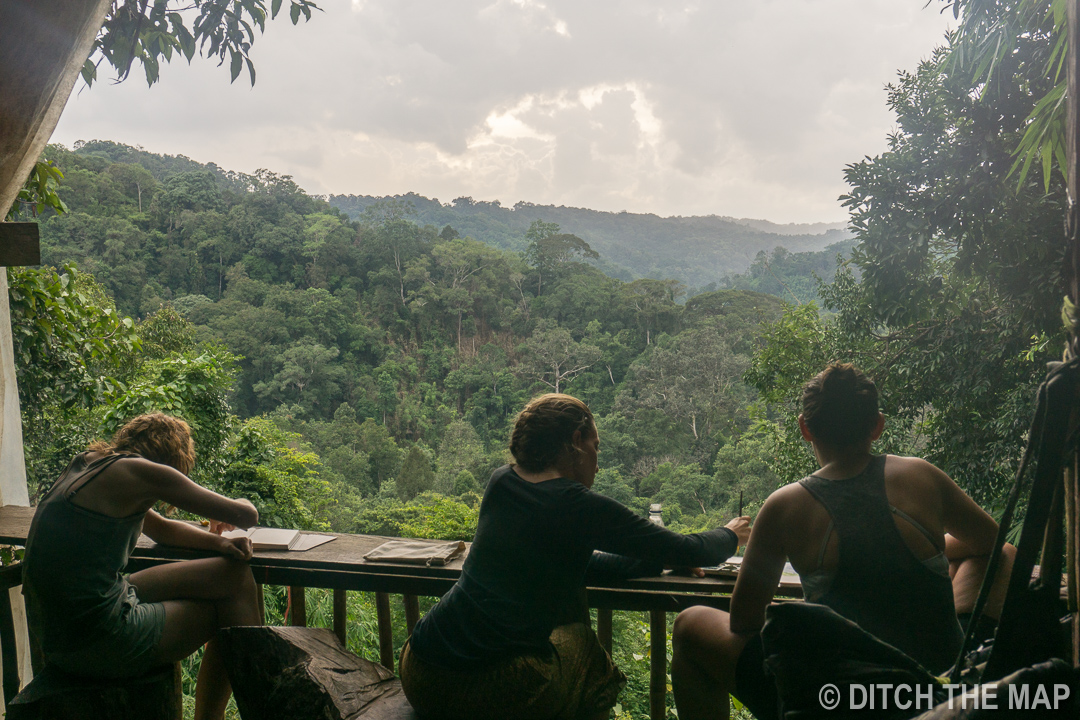
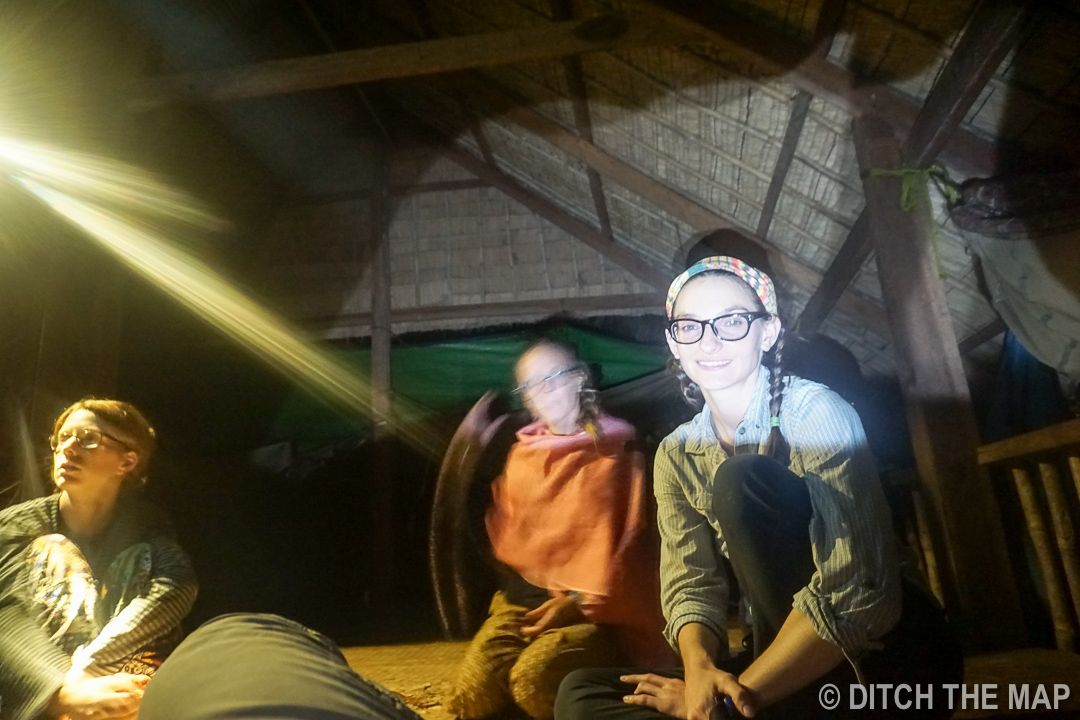
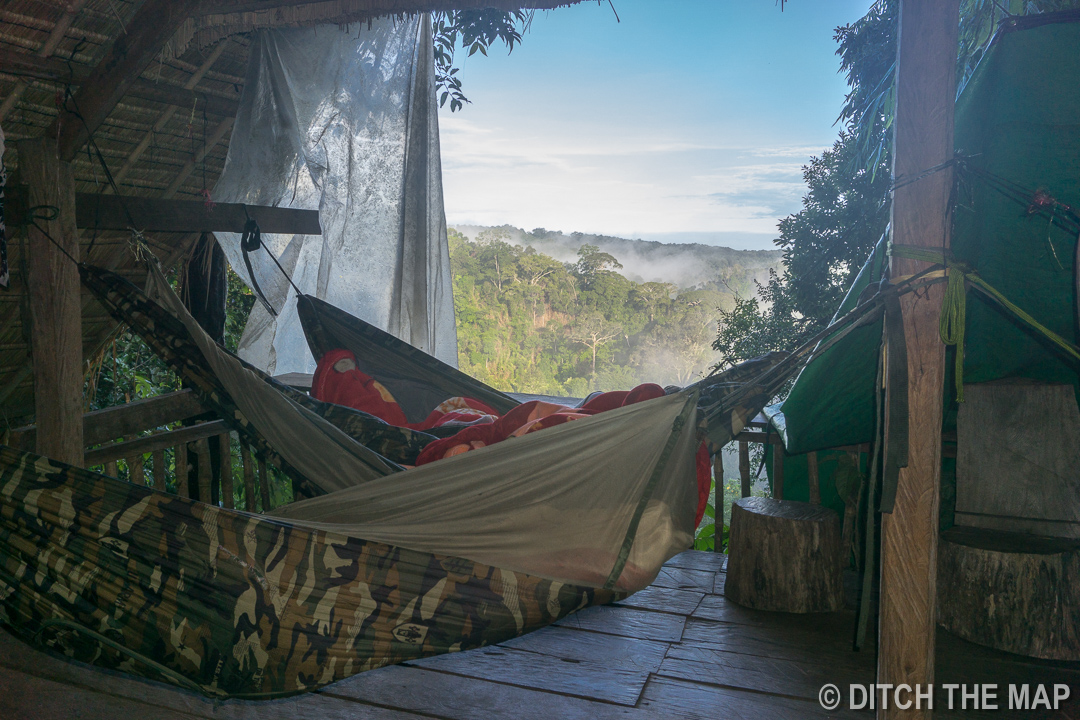
The next morning we set out to tackle 18km of steamy, humid, jungle after noticing that both of our bags had holes chewed through them by mice during the night.. Despite the heat we both were covered in pants and long shirts, to protect against the bugs and sun. After the first hour both Sylvie and I had to remove leeches that had found their ways onto our covered bodies. We trekked, stopping for lunch at a waterfall and then made our way to another 2 waterfalls. Our path even took us behind one of them. It had poured the night before and the jungle floor was slippery, though not as muddy as you would think. Our walking sticks came in handy though. During the walk our guide had told us about his village and his life.
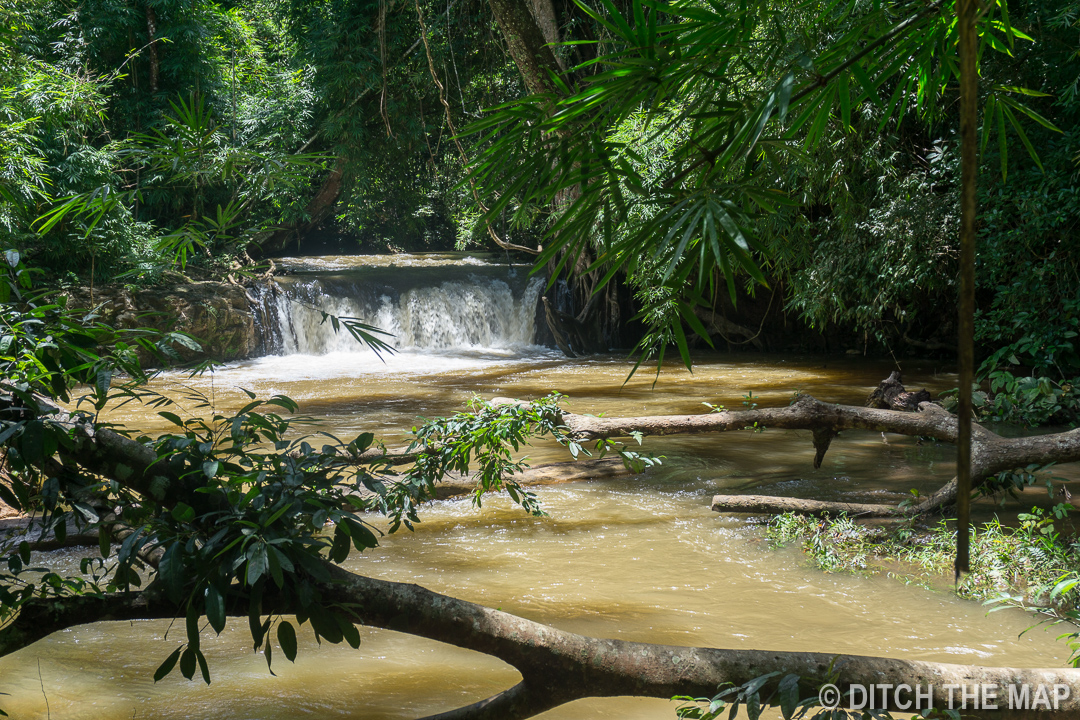

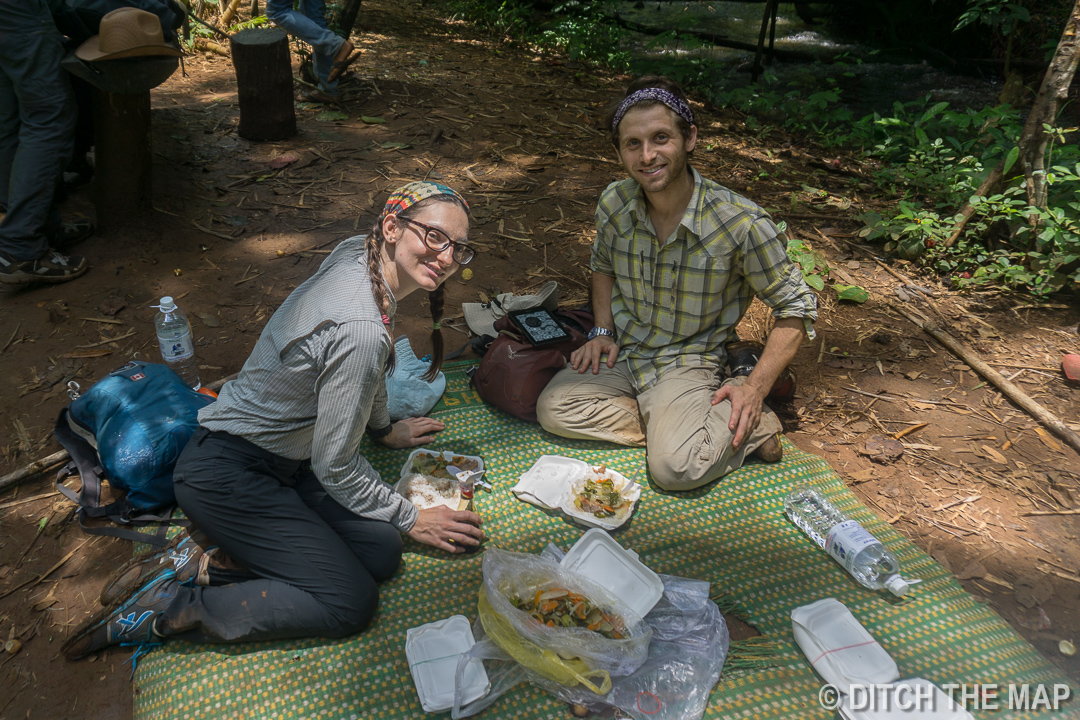
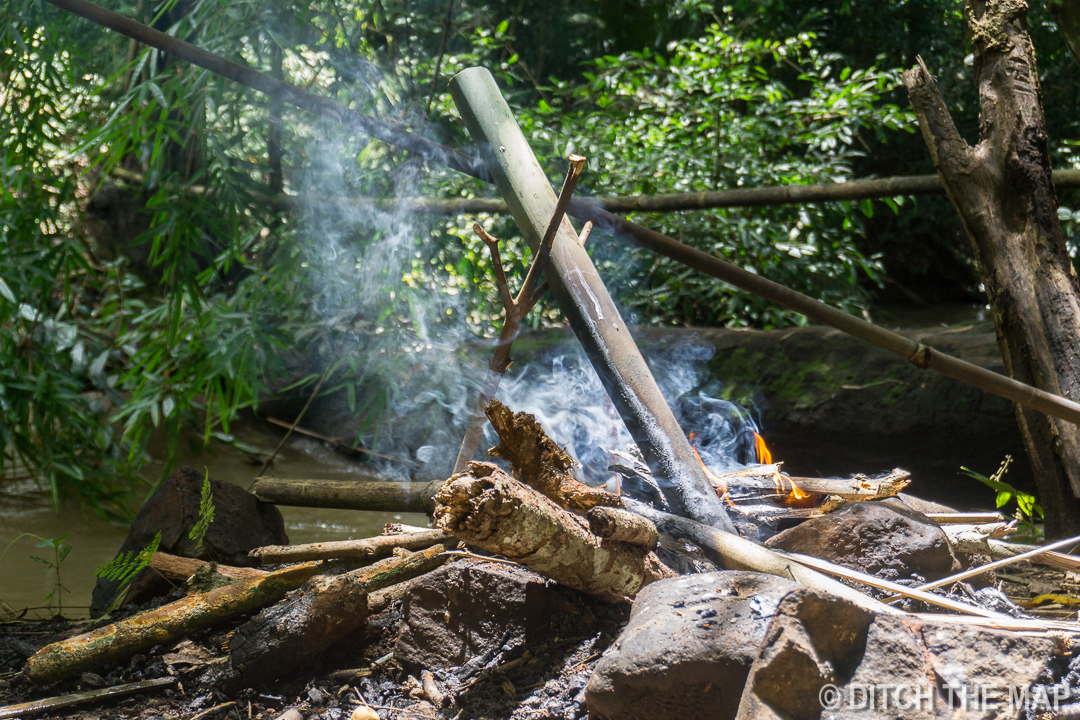
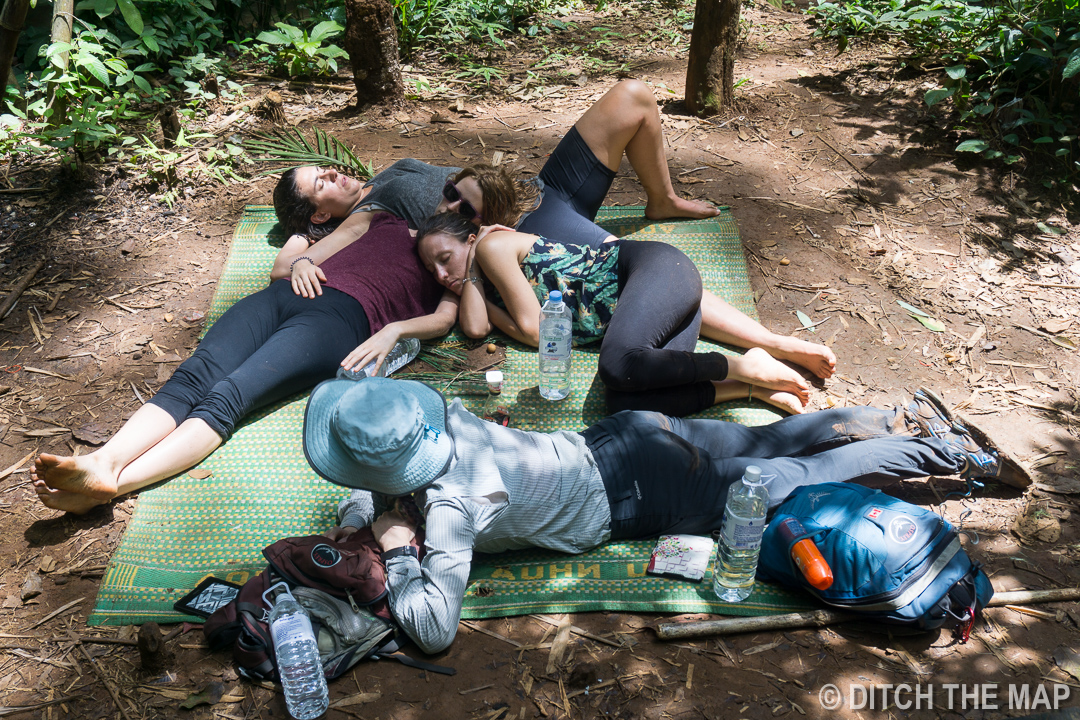
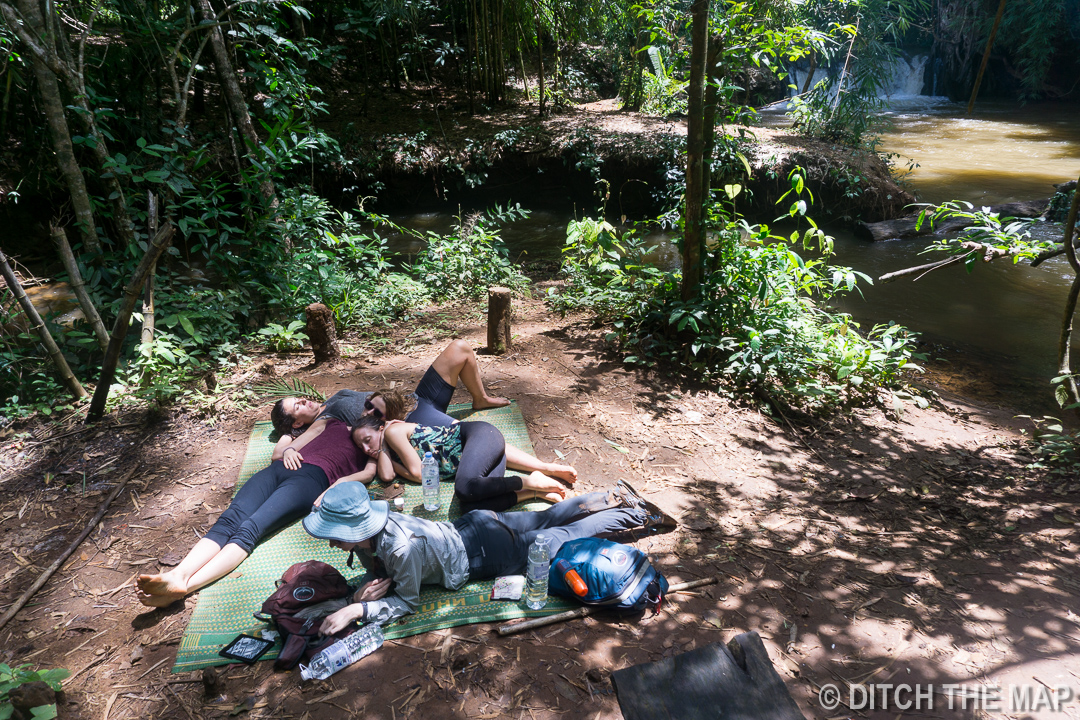
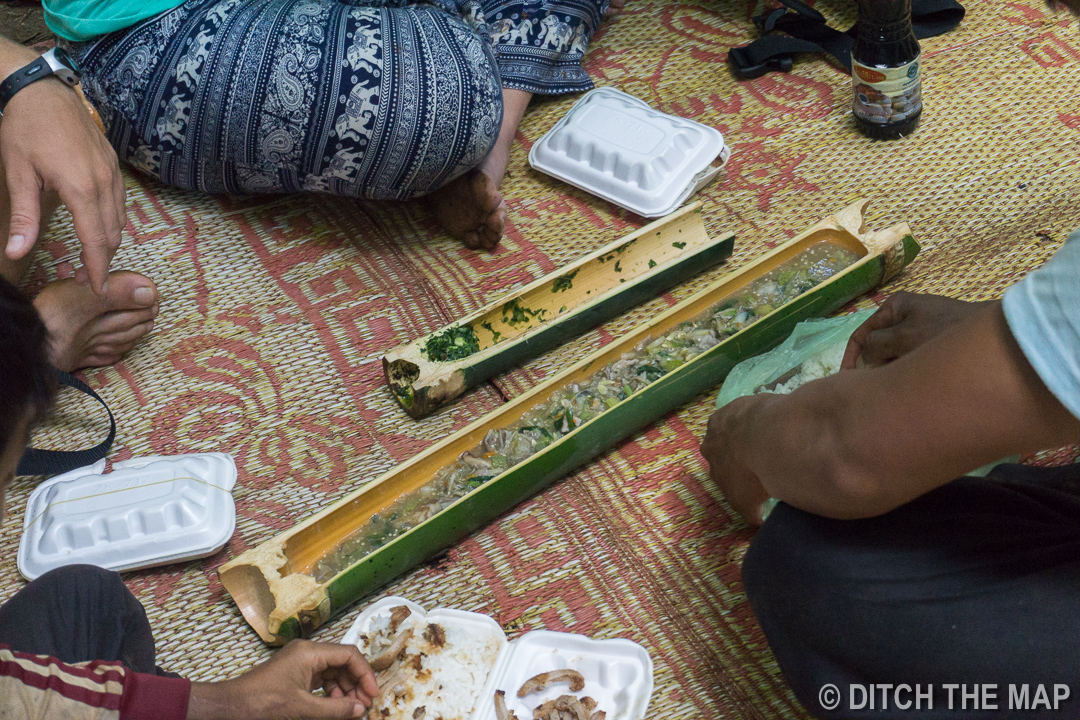
Our guide was a member of the Bunong People, an indigenous population living in the hills of Cambodia. They speak a different language then the Khmer and are not buddhist. They are animists, which means they believe in spirits, or ghosts as our guide had said. Now they wear 'normal' clothing but several generations ago they dressed in simple clothing made from the leaves. We learned how the Benong people treat illnesses. They typically go to spirit doctors who use herbs and other natural remedies. Sometimes they use sticks to beat the evil spirits away. It's quite an image to think of an older spirit doctor beating a little kid with a stick.
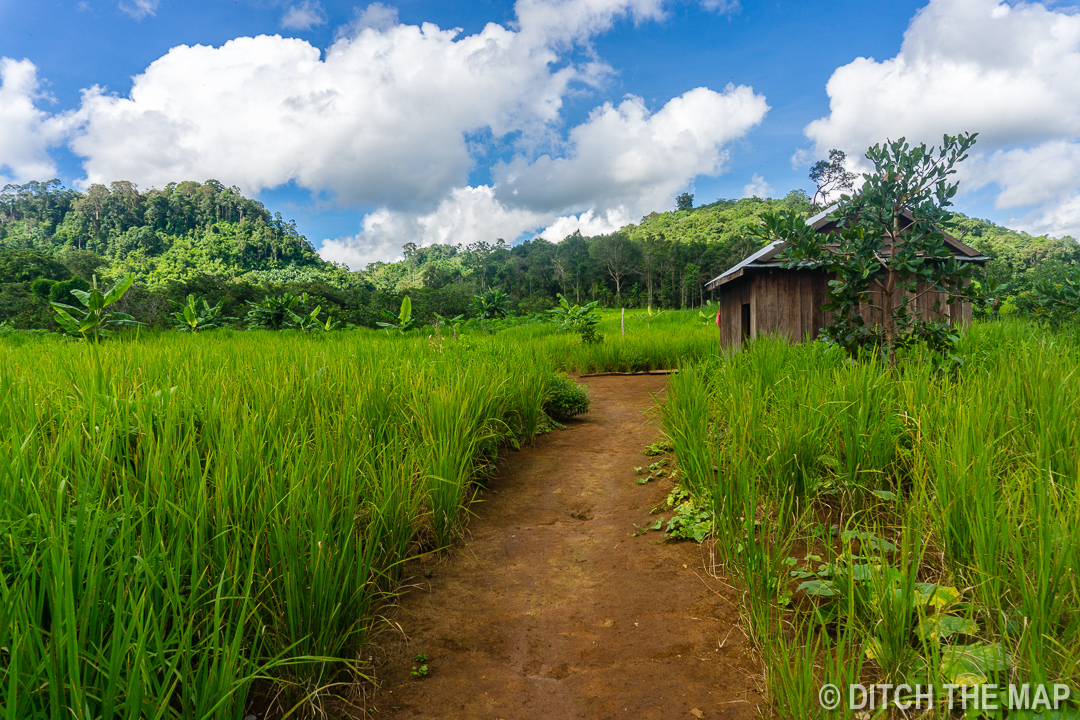
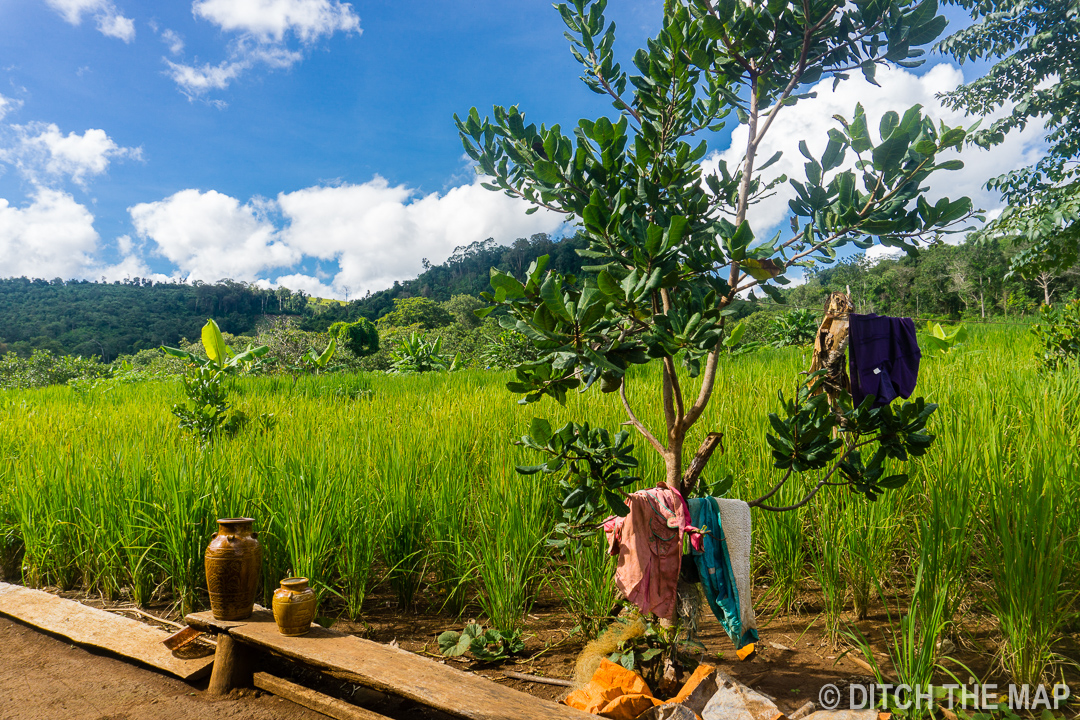
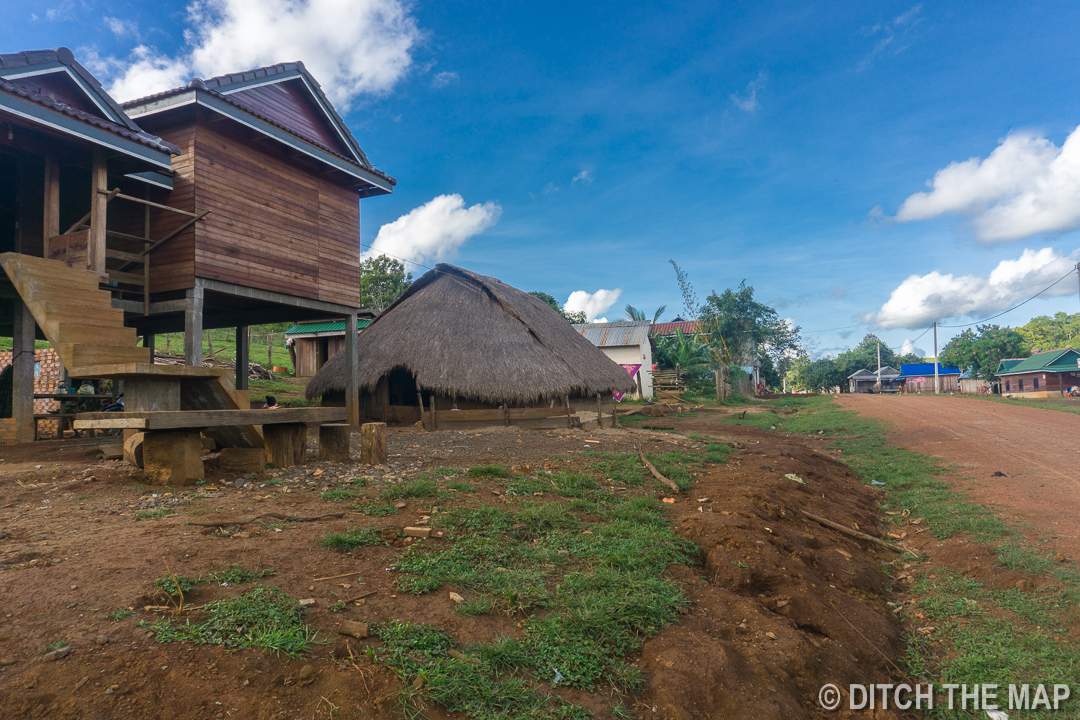

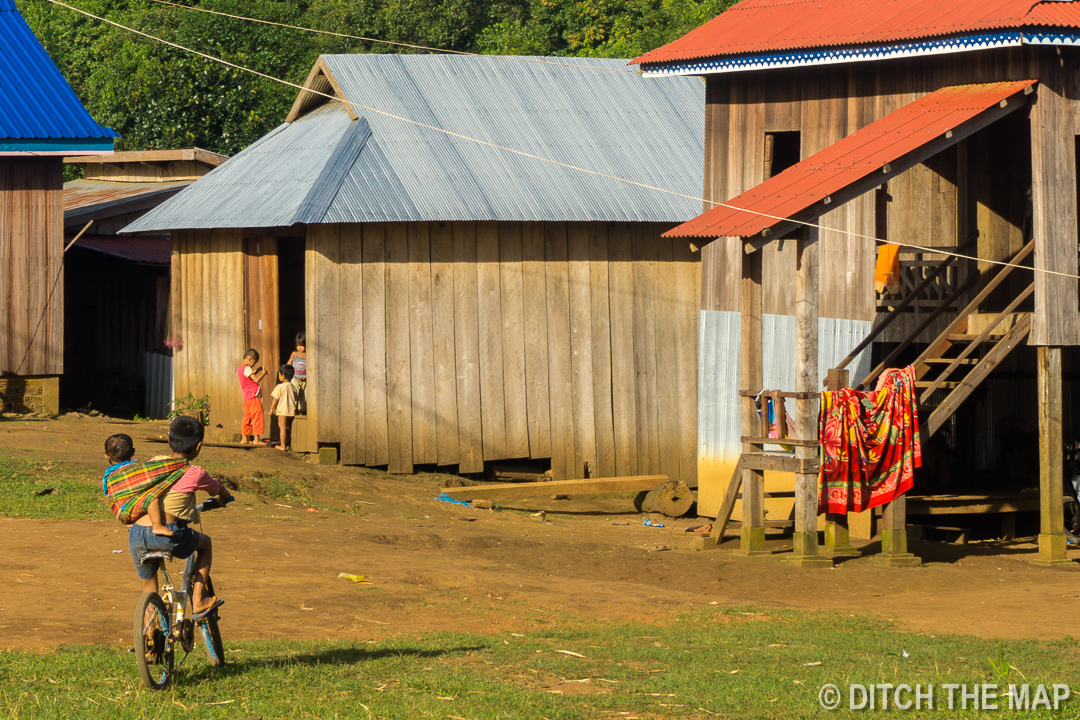
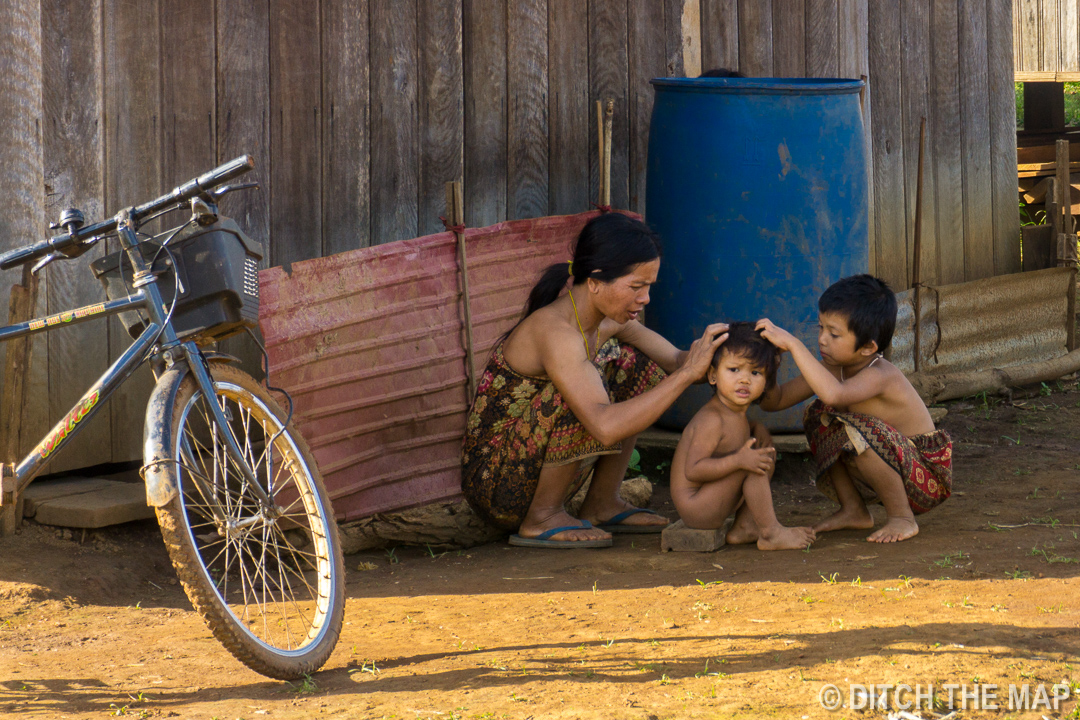
Our guide was a very friendly person and spoke English very well considering he has only been learning for the last 7 months. Tourism has a very large potential to help the Bunong population as currently they are all farmers. The Mondulkiri Project is working closely with the Bunong in an effort to educate them so that they can benefit from the up-and-comming tourism within the area.
Walking Behind a Waterfall in Mondulkiri, Cambodia (click to view)
During our hike to the village we met our guide's grandmother. She was outside drying corn and peppers. The Bunong don't have refrigeration so they dry all the food they cannot consume. When the time comes to eat meat they soak the dried meat in soup and then eat it. They also don't eat any foods that contain chemicals. They only eat animals, fruits, and vegetable that they grow themselves. There are people that come all the way from Phnom Penh to buy their organic produce.




